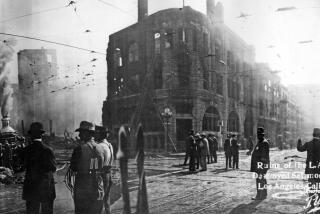Editors Consider Publishing Manifesto : Terrorism: The New York Times and Washington Post have a two-month deadline. Some experts say that printing the document will escalate the Unabomber’s demands.
SACRAMENTO — For 17 years he has remained steadfastly silent, a shadowy terrorist killing and maiming with no explanation of motive or goals. But now the Unabomber has spoken, vowing to halt his lethal campaign if his 35,000-word manifesto is published in the New York Times or the Washington Post.
The life-and-death demand has ignited furious debate among law enforcement officials, psychologists and others who have tracked the bomber. If his anarchist views are published, they wonder, will the violence truly stop?
“It’s the million-dollar question,” said Lt. Joe Enloe, a homicide detective in Sacramento. “Do you believe him or do you figure it’s all a big joke?”
As the newspaper executives weigh their options, time ticks steadily away. In making his “publish or perish” demand, the Unabomber gave the papers three months--until the end of September--to decide whether to accept his bargain or risk more mayhem by mail.
Some investigators argue that sharing the manifesto with millions of newspaper readers could enhance the odds of the Unabomber’s capture. If the terrorist’s words are exposed, they say, an acquaintance or relative or even a former college professor might recognize his writing style and turn him in.
Several psychologists, meanwhile, suggest that publication of the bomber’s views might have a healing effect, fulfilling his obvious desire for attention and thereby quenching his need to blow people up.
“It [publication] would be a triumph for him, a true accomplishment,” said Dr. William Vicary, a Los Angeles psychiatrist who has studied the Unabom case. “From a mental health perspective, perhaps this would defuse a lot of his frustration, his resentment and his feeling that nobody respects him or pays attention to him.”
Many other experts, however, say publishing the manifesto would be unwise. By granting the Unabomber’s wish, they say, the newspapers would be translating his grandiose fantasies into reality. The trouble with that, according to psychologists, is that such fantasies can never be fully satisfied.
“His demands will just keep escalating,” predicted Reid Meloy, a forensic psychologist who has tracked the serial bomber. “The next thing you know, he’ll demand that all Gideon Bibles in motel rooms across America be replaced with leather-bound copies of his manuscript.”
Criminologists tend to agree. Attempting to placate the Unabomber by publishing his “rantings” would only “inspire him upward and onward,” said Jack Levin, a serial murder specialist at Northeastern University in Boston.
“This is a guy who’s got to kill to stay powerful and stay in the spotlight,” Levin said.
Sgt. Bob Bell, a Sacramento County sheriff’s detective who has hunted the Unabomber since one of his devices killed a computer store owner here in 1985, said it is tempting but foolhardy to take the Unabomber at his word.
“If he had a record of credibility, [publishing] it might be worth a try to save some lives,” Bell said. “But this guy’s not going to keep his promise. This is extortion.”
Ultimately, the quandary of whether or not to publish the 56-page manifesto is one that must be resolved by the New York Times and the Washington Post. Spokeswomen for the newspapers would not comment on their deliberations and said a final decision had not yet been made.
Titled “Industrial Society and its Future,” the Unabomber’s typewritten essay argues that a corrupt, “industrial-technological society” is destroying the freedom of human beings and must be demolished. It calls the Industrial Revolution a “disaster” and advocates the destruction of capitalism and factories and the burning of technical books.
Carefully footnoted, the manifesto reads like a serious, scholarly thesis. The author’s grammar is correct, his spelling quite good.
The Unabomber describes himself as a member of an anarchist group called “Freedom Club,” but authorities believe he is acting alone. If he had cohorts, they say, one would likely have become disgruntled or betrayed the cause sometime during the 17-year bombing campaign, which has killed three people and wounded 23 more.
If published, the manuscript would consume seven full pages of newsprint. More troubling to the newspapers, however, is a postscript to the Unabomber’s demand--a requirement that they publish three more annual messages from him.
Moreover, he has promised only to stop killing people, not bombing altogether. The terrorist said he might shift his attacks to machines and installations--even if one or both of the papers print his manifesto.
In a macabre twist, the bomber also mailed his manuscript to Penthouse magazine--but said that if only the magazine publishes it, he reserves the right to kill one more person. In a letter to Penthouse Publisher Bob Guccione, the Unabomber said he regards Penthouse as an “entertainment magazine” and would prefer that his work run in a more serious forum.
In an interview, Guccione said that if the newspapers decline to publish, he will do so--but only if the Unabomber retracts his threat to take another life.
FBI officials declined to reveal what advice they have provided the newspapers and Penthouse. But in a press conference last month, the agent in charge of the Unabom task force seemed to express support for airing the killer’s views.
“I’d much rather see communication than bombs,” said the FBI’s Jim R. Freeman. “We’re looking to any means that would mitigate harm to the public safety.”
More to Read
Sign up for Essential California
The most important California stories and recommendations in your inbox every morning.
You may occasionally receive promotional content from the Los Angeles Times.










